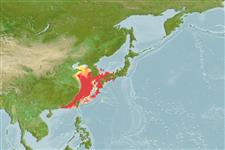Environment: milieu / climate zone / depth range / distribution range
Ecology
Marine; benthopelagic; oceanodromous (Ref. 51243); depth range 20 - 140 m (Ref. 75716), usually 40 - ? m (Ref. 2113). Temperate; 39°N - 22°N, 114°E - 136°E
Northwest Pacific: from Hong Kong to north Korea Yellow Sea, then east to Kii Peninsula, Japan.
Length at first maturity / Size / Weight / Age
Maturity: Lm ?, range 14 - ? cm
Max length : 40.0 cm SL male/unsexed; (Ref. 75716); common length : 20.0 cm TL male/unsexed; (Ref. 2113)
Dorsal spines (total): 11; Dorsal soft rays (total): 25 - 28; Anal spines: 2; Anal soft rays: 7 - 8; Vertebrae: 25. Posterior end of pectoral fin reaching or extending past the posterior end of spinous dorsal fin. Tip of lower jaw and inside of lower jaw teeth without or indistinct dark markings. Length of second anal spine almost equal to eye diameter (Ref. 41299).
Inhabit coastal waters in sandy, muddy bottoms (Ref. 75716). Feed on small fishes and invertebrates (Ref. 2113). Marketed fresh and dried.
Trewavas, E., 1977. The sciaenid fishes (croakers or drums) of the Indo-west Pacific. Trans. Zool. Soc. Lond. 33:253-541. (Ref. 5369)
IUCN Red List Status (Ref. 130435: Version 2024-2)
Threat to humans
Harmless
Human uses
Fisheries: commercial; gamefish: yes
Tools
Special reports
Download XML
Internet sources
Estimates based on models
Preferred temperature (Ref.
123201): 16.7 - 23.4, mean 20.9 °C (based on 31 cells).
Phylogenetic diversity index (Ref.
82804): PD
50 = 0.5312 [Uniqueness, from 0.5 = low to 2.0 = high].
Bayesian length-weight: a=0.00851 (0.00776 - 0.00934), b=3.08 (3.06 - 3.10), in cm total length, based on LWR estimates for this species (Ref.
93245).
Trophic level (Ref.
69278): 4.1 ±0.7 se; based on diet studies.
Resilience (Ref.
120179): High, minimum population doubling time less than 15 months (K=0.76; tm=1).
Prior r = 0.57, 95% CL = 0.37 - 0.85, Based on 1 data-limited stock assessment.
Fishing Vulnerability (Ref.
59153): Low to moderate vulnerability (34 of 100).
Climate Vulnerability (Ref.
125649): Low to moderate vulnerability (34 of 100).
Nutrients (Ref.
124155): Calcium = 30.1 [16.4, 60.3] mg/100g; Iron = 0.286 [0.137, 0.527] mg/100g; Protein = 18.7 [17.5, 20.0] %; Omega3 = 0.641 [0.310, 1.200] g/100g; Selenium = 14.9 [7.1, 30.9] μg/100g; VitaminA = 21.9 [5.4, 90.7] μg/100g; Zinc = 0.518 [0.357, 0.780] mg/100g (wet weight); based on
nutrient studies.
